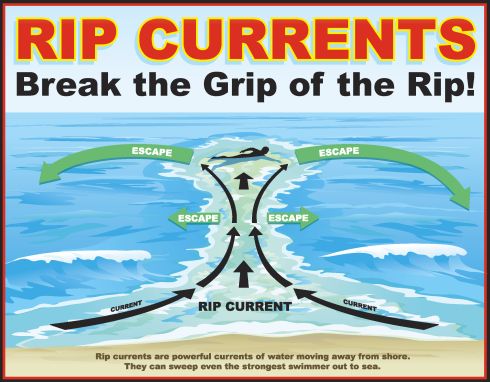Learning to surf for the first time can be a daunting experience. With the crashing waves, rocks, changing tides and rip currents, these somewhat unpredictable variables can sway a person from getting into the ocean for a swim, let alone trying to surf. However, if you know and understand ocean safety and how the dynamics of the ocean works, it can be a complete game changer and can be used to your advantage in the water.
Below are 4 fundamental elements to be aware of when learning to surf.
A Rip Current
A rip is a strong current running out to sea.
One of the best visual identifiers of a rip current is to look out for gaps between the waves. The calmer gap between waves may look safer for you to surf in but a small patch of calm water in an otherwise choppy sea is often a rip current. Rips are the cause of most rescues performed at beaches. A rip usually occurs when a channel forms between the shore and a sandbank, and large waves have built up water that then returns to sea, causing a pulling effect. The larger the surf, the stronger the rip. Rips are dangerous as they can carry a surfer out to the backline which may seem scary at first, but like most things in life, there are pros and cons to the situation.
I personally look for a rip current. Picture the current as a free Uber ride to the backline. The key here is to know how to get off the Uber ride. A rip current is pulling from the shore to the back and further out into the ocean. So the logical thing to do is to paddle against it, right? Wrong! Paddling against it would be like trying to run on a treadmill in the hopes of moving forward. You will either stay in the same place, tiring yourself out or it’ll overpower you and push you further out anyway.
So how to get out of a rip current? It’s simple, you paddle perpendicular to where the current going or rather parallel to the shore. The image below explains it clearly.

Changing Tides
A change in the tide goes hand in hand with rip currents. A rip generally starts to form when the tide is dropping (going low). This is not only a potential risk of being pulled out to sea but when the tide starts to drop, the waves (depending on the swell size) become steeper, faster breaking and break further out than the higher tide. As the sea level rises and falls, waves will hit the coast in either deeper or shallower water causing it to break differently. Without a reef, sandbar or shoreline, waves would never break at all. Although the changing tide is not necessarily a danger it can become challenging for a beginner surfer and can start to become rather frustrating to get out to backline to catch waves. As you progress in your surfing, you’ll find yourself wanting to surf more on the low tide opposed to the high. For the above reasons… More challenging waves.

Rocks & Piers
Although this may seem like an obvious one, I have seen beginners try to paddle out in some hairy condition, namely, trying to paddle out over shallow rocks. Because (and this is my favourite saying) You don’t know what you don’t know? This is why I am telling you. Don’t do it. You wouldn’t go jump off a waterfall into extremely shallow water? The same applies to surfing. Believe it or not, rocks are hard and don’t tend to move for humans. Being slammed into a rock by a wave can cause some serious injury and potential damage to your surfboard. The name of the game is to have fun, right? Not get injured.
However, as you progress in your surfing you will see that some rocks or piers that stretch far out into ocean, cause a rip next to them. This can be used like a conveyor belt and you could grab a ride out to the backline, sometimes with your hair dry. I suggest only doing this at low tide as the high tide tends to stop the rip from happening and could potentially wash you into/onto the rocks. In the beginning it’s wiser to stay away from rocks or piers.
Rocks can also be used as a landmark too. As the rising or dropping tide causes rips it is a great idea to glance over at a landmark on shore to ensure you’re always sitting in the right place to catch the ride of a lifetime.

Bring a surf buddy
This is another one of those, under the radar things that seem to slip the mind. It is always safer to surf with a bud. For many obvious safety reasons from looking out for each other to being able to call for help if one or the other is in danger. Plus surfing with a mate is the best! Sharing waves and having a laugh is always one of my top things to do. You cannot put a price on those moments shared in the ocean. 🙂
See you out in the lineup! (safely)
Chad